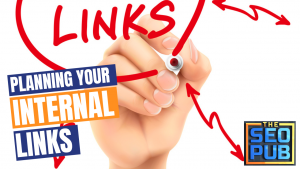This is going to be a long one.
Let’s talk about some best practices for anchor text in your link building. Some of this is probably going to go against what you may have heard from some of the “gurus” out there, but stick with me.
First, I’m going to start with my own personal golden rule of anchor text. I have been following this for 12-15 years. If you get nothing else out of this post, but this one thing, you will be fine.
Your anchor text should either describe why you are linking to a page or it should describe what the page you are linking to is about. That’s it.
It’s as simple as that. This goes for both internal and external links. In this way, your anchor text is both SEO-optimized and serves web visitors well.
Never intentionally use naked URLs as anchors. It is one of the absolute dumbest ideas I have ever heard. No, it is not “natural”. Not one bit.
I think we can all agree that some of the most “natural” links you will find are links within the content of an article. Nobody links with naked URLs in articles. That was not at all common until SEOs started doing it.
If you were writing an article about how to build a PC, you wouldn’t say something like:
Looking at their selection and prices, I would not recommend shopping for PC components at hxxp://bestbuy.com.
You would use something like:
Looking at their selection and prices, I would not recommend shopping for “PC components at Best Buy.” (Where the words in quotes are the anchor text)
That is much more “natural” and makes way more sense.
You do not need to use naked URL links to make your link profile look natural. I have been doing SEO since 2003 or 2004. In all of that time, I can tell you exactly how many times I have intentionally built a link with a naked URL as the anchor text. Zero. Exactly zero. The only time I have done it is when I have been forced to in things like press releases or directory listings that had no other option.
I know many people will look at big brands and see that they have a lot of links with naked URLs as anchor text and believe that is proof that you need them, but what you have to remember about big brands is they do actual PR. A lot of that PR work includes things like press releases which only have an option for naked URL links.
If you really believe that you need links with naked URL anchors and I cannot convince you otherwise, there are plenty of directories out there that only allow those types of links. Save them for those.
Do not waste good link opportunities with naked URLs, and especially never do it with internal links. I did a consulting call yesterday with a business owner and their “SEO” who were looking for some extra help. Many of their internal links were using naked URLs for anchors. One of the dumbest things I have ever seen on a site. When I asked why, the SEO stated it was to make their link profile look natural.
If I could have reached through the Zoom call and throat-punched the SEO, I would have.
Should you worry about anchor text ratios? This might be an unpopular opinion, but I’m going to say no. Yes, I know you have probably heard how important anchor text ratios are, again, in making your link profile look “natural”.
I personally have never found any solid evidence of this. This notion all came about right after Penguin was released. I know many in this group were not involved in SEO back then, so a little history lesson then…
When Penguin first released and many people saw websites tanking all over the place, mostly spammers, there was quite a bit of panic in the community. Nobody knew for sure what they had targeted (although the 750,000+ spam warnings that went out just a few months before in Search Console, Webmaster Tools at that time, gave us a pretty good hint). Within a few days there was an article published on a site declaring that they had figured it out and one of the main things Penguin was targeting was sites using high ratios of the same anchor text. If I remember correctly, it was a group called Microsite Masters, but don’t quote me on that. And I don’t think it was the same owners of that site today.
This article spread like wildfire. People were so panicked and desperate for answers at that time, most never bothered to question it.
What this article failed to account for was common practices of most spammers. Back then there were a lot more people using tools like Xrumer, SENuke, Bookmarking Demon, Sick Submitter, etc. to build massive amounts of low quality links. You could shoot out a few hundred thousand links in a matter of days with these tools if you knew what you were doing and had the right setup.
What spammers would do is if they wanted to rank for “lowest rate mortgages” that is what they would use for the anchor text for pretty much all of their links. If not that, then very close variations. It was not uncommon to see pages ranked with spam that had 75-90% of the same anchors in their link profile.
But was it really the anchor text that got them caught in the Penguin filter or was it the low quality links they were using? There were tons of sites hit by Penguin with much more varied anchors in their link profiles.
I still maintain it was the low quality links Penguin picked up on. The anchor ratios were just a byproduct of how spammers did things back then. I tested it many times using more varied anchor text and Penguin would still catch the sites eventually.
Let’s think of it another way. What if you created the world’s best online mortgage calculator and it went viral? What anchors do you think people are going to use to link back to that page?
I would bet that 90% or more of the anchors are going to be either “online mortgage calculator” or “best online mortgage calculator”. Is Google really going to punish a page for that? It would not make any sense.
Now all of that being said (like I said at the beginning stick with me), I would recommend varying up your anchors. I have always done this (it goes back to my anchor text golden rule above), but not because of some worry about anchor text ratios getting my pages in trouble with Google.
I do it because I’m never trying to rank a page for just a single keyword. There are usually quite a few variations I am targeting. The other reason I recommend varying up your anchors is that by doing so you are giving search engines more clues as to what the page is about.
But I will never tell anyone that they should shoot for X% of naked URLs, X% of brand name anchors, etc. That just makes zero sense. In fact, doesn’t shooting for some artificial percentages actually go against everything about your link profile looking “natural” in the first place?
Again, if you get nothing out of this admittedly long rant, just remember my rule for anchor text.
Your anchor text should either describe why you are linking to a page or it should describe what the page you are linking to is about.
That’s it. If you just do that, you will be fine.



2 comments
Cassie C
Your SEO tips are inspiring and engaging. I love learning about your SEO best practices because they are filled with historical information and stories about past search techniques, where it was or wasn’t relevant, and how that is appropriate in today’s landscape.
Mike
Thank you. I appreciate that. And thanks for stopping by.
Comments are closed.